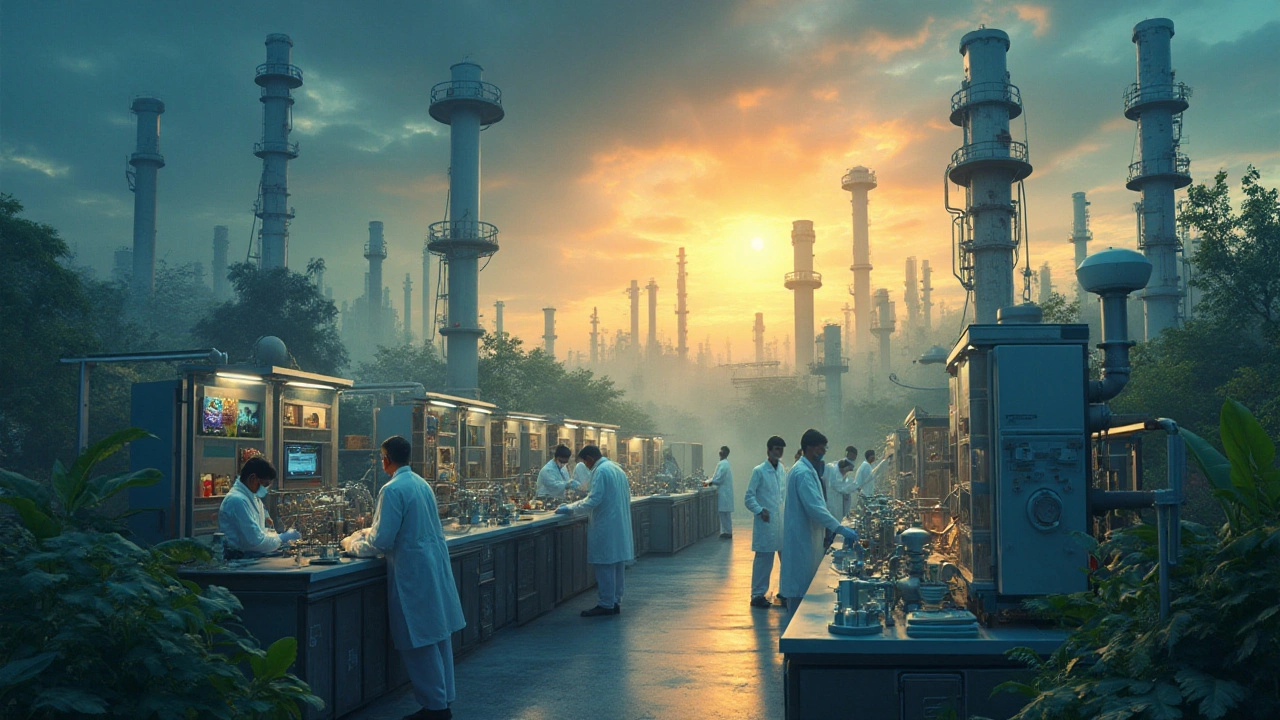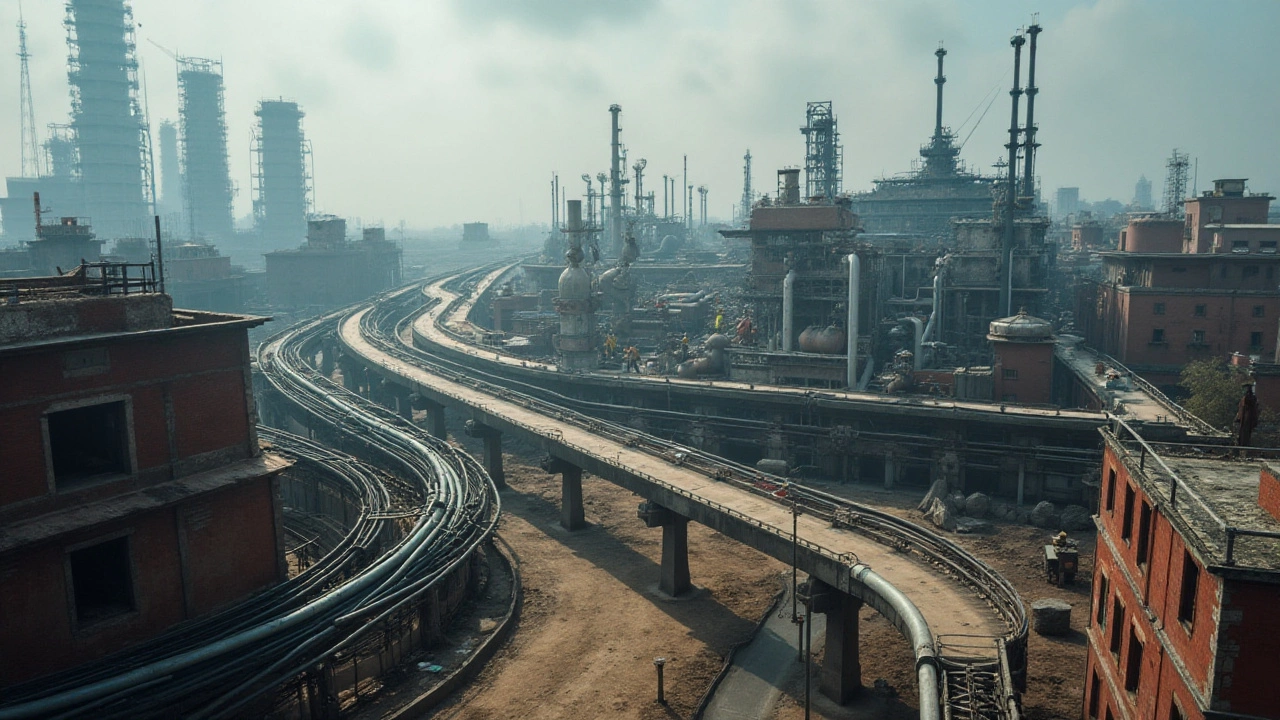India's chemical manufacturing sector, a vital pillar of the economy, remains laden with challenges that hinder its expansion. While the nation has shown promise in various industries, chemical manufacturing struggles to reach its full potential. This is a complex issue rooted in a blend of regulatory, infrastructural, and competitive hurdles.
Understanding these underlying factors is essential for comprehending why growth has been sluggish. Despite the vast market opportunities and resources available in India, the chemical industry's path is fraught with obstacles that need addressing. This article delves into these challenges and explores possible solutions for revitalizing the sector.
- Current State of the Chemical Manufacturing Sector
- Regulatory Challenges
- Infrastructure and Logistics Issues
- Competitive Landscape
- Pathways to Growth
Current State of the Chemical Manufacturing Sector
The chemical manufacturing sector in India is a crucial component of the industrial landscape, contributing significantly to the economy and employment. This industry encompasses a wide array of products, including petrochemicals, pharmaceutical chemicals, industrial chemicals, and specialty chemicals. Despite its potential, the sector's growth has encountered several obstacles that are linked to a mix of domestic and international factors.
In recent years, the Indian chemical industry has experienced moderate growth, but not at the pace required to significantly boost the economy. The global demand for chemicals is steadily increasing, and while India has shown an ability to respond to these demands, there are underlying inefficiencies that must be addressed. The sector is endowed with a vast labor force, relatively low production costs, and access to raw materials, yet it often faces hurdles in infrastructure and regulatory issues that impede its full growth potential.
One of the key aspects of the chemical manufacturing sector is its potential for export growth. India ranks sixth globally in terms of output and exports a significant portion of its chemical products. However, the country is yet to fully exploit this opportunity. The domestic consumption rates are high, but they seldom translate into enhanced production capabilities, partly due to inadequate innovation and investment in research and development.
Another challenge is the competitive landscape. While some Indian companies have attained a degree of international competitiveness, many remain regional players who find it challenging to compete on a global scale. This lack of competitiveness can be attributed to the prevalence of smaller, less efficient producers who struggle to invest in advanced technology and scalability.
A report by the Indian Chemical Council highlighted, "The primary need of the hour is an integrated approach towards policy-making that facilitates industry growth, leading to a more prominent global standing." This statement underscores the necessity of synergized efforts between policy-making bodies and industry leaders to craft a conducive environment for growth. Investments in skill development, research, and modernization of facilities could drive this transformation.
To enhance its stature on the global stage, the Indian chemical manufacturing industry must contend not only with local challenges but also with the shifting sands of global trade policies and market dynamics. Collaboration, both within the country and with international peers, could potentially redefine India's manufacturing capabilities. In this context, charting out a roadmap for sustained growth with emphasis on sustainable practices will be key to repositioning India's chemical industry in the global market.
Regulatory Challenges
The regulatory environment in India poses significant hurdles for the growth of the chemical industry. Stringent and often overlapping regulations create a complex maze for manufacturers. Navigating through various state and central policies can be daunting, as compliance often involves cumbersome paperwork and prolonged waiting periods. These challenges diminish the sector's competitiveness in both domestic and global markets, prompting many businesses to reconsider their investment plans or seek other more conducive environments for growth.
One of the critical issues is the lack of a unified framework. The absence of a cohesive regulatory structure means companies have to wade through multiple authorities. This includes adhering to not just environmental norms, but also safety standards and import-export regulations. While each is integral in its way, the failure to streamline these processes results in delays that hinder productivity and economic performance. The bureaucratic red tape is a burden for many firms, deterring new entrants and hindering expansion plans for existing players.
In recent years, there have been efforts to address these concerns. Policies like the “Make in India” initiative aim to simplify business processes and encourage manufacturing growth. However, the translation of these policies into effective regulatory reform often meets resistance due to entrenched practices and inadequate implementation at the ground level. The challenge lies not just in formulating policies but in executing them effectively across different jurisdictions. As one expert in the field noted, "The real test of regulatory changes is seen in the reduction of compliance costs and time spent in attaining necessary permits."
According to the Confederation of Indian Industry, delays in regulatory approvals alone can increase the cost of investment projects by up to 15%.To tackle these regulatory hurdles, industry leaders are advocating for a more integrated approach. There is a call for a single-window clearance system that can handle all compliance needs efficiently. Such a system would require advanced digital tools and a robust support framework to be effective. Additionally, regular dialogues between government bodies and industry stakeholders are crucial to understand core issues and develop more pragmatic solutions. By fostering a cooperative regulatory environment, India can unlock the full potential of its manufacturing sector, helping the economy achieve sustainable growth.

Infrastructure and Logistics Issues
Infrastructure and logistics stand as two of the most significant obstacles facing India's manufacturing growth, especially within the chemical industry. Poor infrastructure is not just an inconvenience; it significantly increases operational costs and slows down the expansion. Roads in rural areas, which form a substantial part of India's manufacturing zones, are often under-maintained or inadequate for heavy-duty vehicles required to transport raw materials and finished products. Rail networks, although extensive, are still burdened by inefficiencies such as congestion and outdated scheduling systems. Without reliable transportation channels, the chemical manufacturers face delays and increased inventory costs, diluting their competitive edge in the international market.
Additionally, port facilities, crucial for national and international logistics, struggle with their own set of challenges. Despite being one of the largest maritime nations, India's port infrastructure is marred by long turnaround times and limited mechanization. This hampers the export of chemical products, a fact exacerbated by an intricate bureaucratic process that often leaves shipments stuck in administrative limbo. To quote an industry expert, "India's logistic inefficiencies could cause us to miss out on the global trade boom." This is further affirmed by statistics showing that improving India's logistic efficiency by even 10% could boost trade volumes by 30%, reflecting the critical need for investments in this sector.
Efforts for improvement are underway, with the government initiating programs aimed at enhancing road and rail infrastructure. The Bharatmala and Sagarmala projects, for example, are ambitious undertakings designed to modernize roadways and port facilities respectively. Yet, progress remains slow. Public-private partnerships have been encouraged to expedite development but finding the right balance between profitability and public service remains a contentious topic. Plus, individual state cooperation is required, which adds another layer of complexity in the vast and culturally diverse country. The inconsistency of electricity supply in manufacturing hubs also poses challenges. Frequent outages can halt production, increase downtime, and damage sensitive machinery and equipment. For chemical manufacturers reliant on precise processes and continuous operations, this results in costly interruptions. Reliable power supply is essential to optimize production lines and remain viable in a competitive global market.
The logistics sector also grapples with a talent gap, lacking a workforce trained in modern supply chain management techniques. This skills deficit hinders the application of advanced technologies that could streamline operations and reduce waste, from automation and robotics to data analytics and the Internet of Things (IoT). Consequently, chemical manufacturers face elevated costs and inefficiencies not just from physical infrastructure inadequacies, but also from human resource issues. To overcome these hurdles, India must invest not only in physical infrastructure but also in education and training, creating a workforce skilled in both modern logistics and chemical industry requirements.
Infrastructure development is critical to unlocking the true potential of India’s chemical manufacturing industry. Improving transportation networks, modernizing ports, and ensuring reliable electricity supply are steps that can alleviate current logistical challenges. As India embarks on this journey, it must remain committed to unifying efforts across federal and state levels, integrating modern technologies, and investing in human capital. Without these concerted efforts, the ambition of transforming India into a global manufacturing powerhouse faces daunting roadblocks.
Competitive Landscape
The chemical industry in India operates within a fiercely competitive landscape, characterized by both domestic players and international giants vying for dominance. The sector is highly fragmented, with a multitude of small to medium enterprises coexisting with large corporations. This diversity creates a dynamic marketplace but also presents several hurdles for growth. Local manufacturers often find it challenging to compete with established global entities, which have the advantage of advanced technology, extensive R&D capabilities, and robust supply chains. Such disparities stifle India's manufacturing progress, making it difficult for many businesses to scale their operations or innovate effectively.
One prominent factor influencing this competitive environment is the cost of raw materials, which often fluctuates due to global market dynamics. Indian manufacturers sometimes struggle to secure supplies at competitive rates, placing them at a disadvantage compared to their international counterparts. Additionally, the country's regulatory framework, while aimed at ensuring safety and environmental standards, can be cumbersome, leading to increased operational costs and delays in project approvals. Navigating these regulations requires time, expertise, and resources, which smaller companies may lack, causing them to lag behind larger, more resource-rich players. In fact, a report by the Federation of Indian Chambers of Commerce & Industry notes that regulatory challenges remain a significant barrier to entry and expansion in this sector.
A competitive edge in this landscape can often be achieved through strategic alliances and partnerships. Some Indian firms have begun collaborating with foreign companies to leverage cutting-edge technologies and access broader markets. Such collaborations, if managed well, can offer significant advantages by combining local market knowledge with advanced technological expertise. Additionally, investing in digital transformation and innovative production techniques emerges as a crucial strategy for staying competitive. Companies that embrace digital tools and automation often find themselves better positioned to meet customer demands with efficiency and flexibility, key components of success in the ever-evolving chemical industry.
"Technology and collaboration are cornerstones of the future for India's chemical manufacturers," says Dr. Vinay Kumar, a leading industry analyst. "By embracing innovation and forming strategic partnerships, Indian companies can overcome many of the competitive challenges they face today."Another critical aspect of the competitive landscape is the attention to quality standards and sustainability practices. With increasing global awareness and regulations on environmental impact, Indian manufacturers are under pressure to adopt sustainable practices that meet international expectations. Those who prioritize eco-friendly processes and materials not only gain a competitive edge but also position themselves as leaders in a market that values sustainability. Emphasizing social and environmental responsibility can enhance brand reputation, potentially leading to greater market share and customer loyalty.
Ultimately, the ability to thrive in this competitive environment requires a multifaceted approach that combines resourcefulness, innovation, and strategic vision. With renewed focus on these areas, the potential for growth in India's chemical manufacturing sector is immense, but it requires overcoming the existing challenges that the competitive landscape presents. By addressing these issues head-on, India can carve out its place as a formidable player in the global chemical industry.

Pathways to Growth
Unlocking the potential of India's chemical industry requires a multifaceted approach that addresses the existing challenges while leveraging the country's strengths. To foster production growth in this sector, enabling policy changes and technological advancements are paramount. First and foremost, easing regulatory barriers is essential. India has a complex regulatory framework that often hampers quick decision-making and efficient processing of industrial permits. Streamlining these procedures would significantly boost confidence among domestic and international investors. Creating a single-window clearance system could make a huge difference in attracting more investments to the sector.
Investing in infrastructure is another crucial necessity. For the India manufacturing sector to truly thrive, a robust logistical network is foundational. At present, lack of efficient transport and logistics facilities escalates costs and impacts delivery timelines. This calls for targeted investments in transportation infrastructure, such as roads, railways, and dedicated freight corridors. Creating chemical parks with world-class amenities and connectivity can offer a conducive environment for manufacturing companies to set up their operations and flourish.
Technology adoption will play an equally important role. Encouraging Indian manufacturers to embrace modern technology can lead to enhanced productivity and reduced environmental impact. Automation, digitalization, and the use of AI and machine learning in production processes can streamline operations, reduce wastage, and increase output. To achieve this, fiscal incentives from the government to support technology upgrades and R&D can be pivotal. Measures like tax breaks or grants could spur companies to invest in cutting-edge technologies that drive efficiency and innovation.
Another pathway involves strategic partnerships and collaborations. Engaging in joint ventures with global players can facilitate knowledge transfer and bring in best practices to the Indian chemical sector. This synergy can be particularly beneficial in developing niche products and entering new markets. Encouraging academic-industry ties is also promising. Partnerships with educational institutions for research can accelerate innovation and ensure the industry stays ahead in emerging technology domains.
"Innovation through collaboration is key," said renowned industry expert Raghav Nair during a panel discussion on manufacturing growth.Lastly, building a skilled workforce is indispensable for sustaining economic challenges. As the industry evolves, the demand for highly skilled professionals who can adapt to new technologies is rising. Initiatives focusing on vocational training and upskilling current workers can help fill this gap. Collaboration between industry and academia can create curriculums aligned with industry needs, ensuring that the workforce is adequately skilled. Encouraging entrepreneurship and incubation centers can also drive new ideas and business models, further propelling growth in India's chemical manufacturing.
